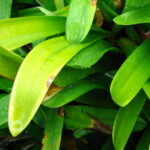Fig trees have been around for centuries. Depending on the variety, they are hardy in U.S. Department of Agriculture zones 6 through 10.
There are over 200 different cultivars of fig trees in North America. Figs are delicious to eat. the bright green leaves have rough feeling hairs on the top, but soft feeling hairs on the underside. Even though the fig trees bear fruit, their flowers do not show. Instead, they develop inside the fruit. Fig trees are practically non-maintenance plants. Once they are established, they will grow without much care. If you have a hardy fig tree growing outdoors, one of the easiest ways to propagate this tree is by ground layering.
Find the Right Stem
Examine the fig tree to find a long, pliable, low growing shoot that is no bigger than an inch thick or about the size of a pencil. Do the bend test. Will it bend to the ground without cracking or breaking? Do you still have at least 3 inches of the tip exposed above the soil level? If not, then find a longer stem.
Mark the area on the ground where the stem makes contact. Remove the grass or weeds in the marked area that measures 8 to 12 inches long and about the same width. Dig up the soil with a trowel or spade to loosen it. If the soil is bad, add 2 inches of organic compost, mixing mix it into the soil. Form a trench with your trowel for the stem to lie in.
Wound the Stem
Lay the stem in the trench Remove leaves, or stems in a 6 to 8 inch area, starting at least 3 inches below the tip. Do not remove the leaves at the tip of the stem. In the in the section where you just removed the leaves, scrape away a thin layer of the bark with a jack-knife or other sharp knife. remove a 2 inch section on the side that will be against the ground. Don’t scrap too deep or you will hurt the stem and the roots will not form.
Some gardeners dust the wound with rooting hormone. If you want to use a rooting hormone, wet the wounded section with your finger dipped in water. Or, you can use a misting sprayer to moisten the stem. Tap the stem with your finger to remove the excess water. Lightly sprinkle the rooting hormone over the wound. Tap or blow the excess rooting hormone away. Do not use too much rooting hormone because it will burn the area instead.
Burying the Stem
Bend the stem to the ground, and hold it in place as you cover the wounded section with soil. Many times, the stem will pop back out of the ground. If this happens to you, pin the stem in place with a rock or a brick. You can also make or buy U-shaped wires. Insert one in the ground where the stem enters the soil and push the other one into the ground where the stem exits. Mark the area with one of those little plastic flags, to help you to remember where you planted the stem.
Watering
Water the soil thoroughly and keep it evenly moist until the stem has rooted. It can take a month or longer for that to happen.
Transplanting
In mid-fall, check the layered stem. If it is growing, and the roots have formed, sever the stem from the parent plant with pruning shears. You can now find a permanent location to transplant your new fig tree.




